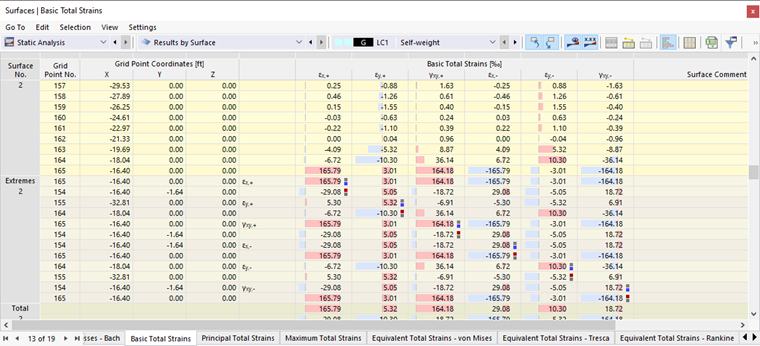In the navigator, define the strains to be displayed on the surfaces. The table lists the strains of each surface according to the specifications set in the Result Table Manager .
The surface strains are subdivided into the following categories:
- Basic Total Strains: strains in the direction of the surface axes
- Principal Total Strains: strains in the direction of the principal axes
- Maximum Total Strains: extreme values of strains
- Equivalent Total Strains: strains analyzed according to different equivalent stress hypotheses
Basic Total Strains
The basic strains are related to the directions of the local surface axes. When analyzing curved surfaces, they refer to the local axes of finite elements (see image Displaying FE Axis Systems ).
The basic strains have the following meaning:
Principal Total Strains
While the basic strains refer to the xyz coordinate system of a surface, the principal strains represent the extreme values of the strains in a surface element. The principal axes 1 (maximum value) and 2 (minimum value) are arranged orthogonally.
The principal strains are determined from the basic strains. They have the following meaning:
It is possible to graphically display the principal axis directions α as "Trajectories" (cf. the image Displaying Trajectories of Principal Axes ).
Maximum Total Strains
This category shows the strain's positive and negative extreme values resulting from the principal total strains.
| εmax,+ | Maximum value of strain on the positive side of a surface |
| εmin,+ | Minimum value of strain on the positive side of a surface |
| |εmax|+ | Greatest extreme value on the positive side of a surface |
| εmax,- | Maximum value of strain on the negative side of a surface |
| εmin,- | Minimum value of strain on the negative side of a surface |
| |εmax|- | Greatest extreme value on the negative side of a surface |
| εmax | Maximum value of strain on the positive or negative side of a surface |
| εmin | Minimum value of strain on the positive or negative side of a surface |
| |εmax| | Greatest extreme value on the positive or negative side of a surface |
Equivalent Total Strains
The Basic Strains are combined according to four equivalent stress hypotheses for the plane stress condition.
von Mises
The approach by von Mises is also called "shape modification hypothesis". This energy is the type of energy that causes a distortion or deformation of the object.
The equivalent total strains according to von Mises have the following meaning:
Tresca
The Tresca hypothesis assumes that the failure is caused by the maximum shear stress.
The equivalent total strains according to Tresca have the following meaning:
Rankine
The hypothesis according to Rankine assumes that the greatest principal stress leads to failure.
The equivalent total strains according to Rankine have the following meaning:
Bach
In the case of the Bach hypothesis, it is assumed that the failure occurs in the direction of the greatest strain.
The equivalent total strains according to Bach have the following meaning:
| εv,Bach,+ | Greatest absolute value of the principal strain ε1,+ or ε2,+ on the positive side of a surface |
| εv,Bach,- | Greatest absolute value of the principal strain ε1,- or ε2,- on the negative side of a surface |
| |εmax| | Maximum equivalent strain εv,Bach on the positive or negative side of a surface |

